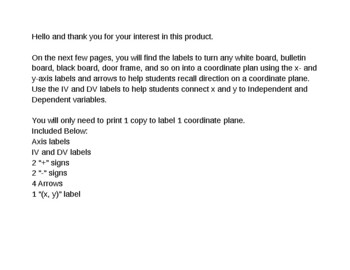Labels to Turn Your Board or Door Into the X-Y Plane
24 Downloads
Kruszka's Math Classroom
0 Followers
Grade Levels
Not Grade Specific
Subjects
Resource Type
Standards
CCSS5.G.A.1
CCSS5.G.A.2
CCSS6.G.A.3
CCSS8.G.A.2
CCSS8.G.A.3
Formats Included
- Word Document File
Kruszka's Math Classroom
0 Followers
Description
Hello and thank you for your interest in this product.
On the next few pages, you will find the labels to turn any white board, bulletin board, black board, door frame, and so on into a coordinate plan using the x- and y-axis labels and arrows to help students recall direction on a coordinate plane. Use the IV and DV labels to help students connect x and y to Independent and Dependent variables.
You will only need to print 1 copy to label 1 coordinate plane.
Included Below:
Axis labels
IV and DV labels
2 “+” signs
2 “-“ signs
4 Arrows
1 “(x, y)” label
Total Pages
Answer Key
N/A
Teaching Duration
30 minutes
Last updated May 21st, 2022
Report this resource to TPT
Reported resources will be reviewed by our team. Report this resource to let us know if this resource violates TPT’s content guidelines.
Standards
to see state-specific standards (only available in the US).
CCSS5.G.A.1
Use a pair of perpendicular number lines, called axes, to define a coordinate system, with the intersection of the lines (the origin) arranged to coincide with the 0 on each line and a given point in the plane located by using an ordered pair of numbers, called its coordinates. Understand that the first number indicates how far to travel from the origin in the direction of one axis, and the second number indicates how far to travel in the direction of the second axis, with the convention that the names of the two axes and the coordinates correspond (e.g., 𝘹-axis and 𝘹-coordinate, 𝘺-axis and 𝘺-coordinate).
CCSS5.G.A.2
Represent real world and mathematical problems by graphing points in the first quadrant of the coordinate plane, and interpret coordinate values of points in the context of the situation.
CCSS6.G.A.3
Draw polygons in the coordinate plane given coordinates for the vertices; use coordinates to find the length of a side joining points with the same first coordinate or the same second coordinate. Apply these techniques in the context of solving real-world and mathematical problems.
CCSS8.G.A.2
Understand that a two-dimensional figure is congruent to another if the second can be obtained from the first by a sequence of rotations, reflections, and translations; given two congruent figures, describe a sequence that exhibits the congruence between them.
CCSS8.G.A.3
Describe the effect of dilations, translations, rotations, and reflections on two-dimensional figures using coordinates.





